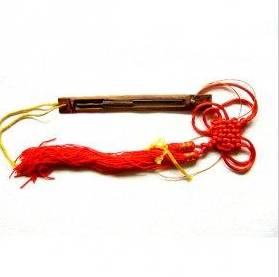Kouxian
Kouxian is smaller than other Chinese musical instruments, but has the longest history among the ethnic instruments. It is said that as early as in the matriarchal society, this instrument had been played. It was then called huang.
Kouxian has been very popular in many places and there are many kinds of it. It may be made of bamboo or metal, and have single or plural pieces of strings. As to performing methods, people may pluck or use the silk thread.
Kouxian consists of a lyre-shaped metal frame that is held between the teeth, and has a projecting iron tongue that is plucked to produce a soft twanging sound. Bamboo Kouxian are about 10-cm long, while metal ones are about 5 cm. People cut the bamboo slim, and carve three tongues in the middle, then cut the bamboo patch into the shape of a sword and the end into the neck. The tongue is big and thin in the head, narrow and thick in the middle, and the two sides are cut into bevel face connected to the head. When players pluck the head, the tongues produce the sound by liberating. Multi-spatula kouxian can be made by binding two or five bamboo spatulas together. The tones of the instrument depend on the length, width and the thickness.
When playing kouxian, the performer puts the neck between his thumb and index finger, and the tongue between his lips. Then he plucks the top of the instrument with his thumb and index finger, which makes the tongue liberate and give out bright sounds. The kind performed by drawing the silk thread is even more special. Performers tie the silk thread to the top of every spatula, and the other end to the fingers of their right hand. Sounds are produced by drawing the thread, which makes the spatula liberate. To raise the volume, performers should pop the lips, to shape like a canister. They can also perform the music with various tones through controlling of their ways of breathing and oral forms.
